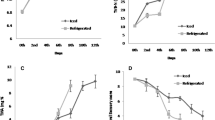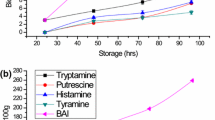Abstract
Biogenic amines formation in Indian mackerel of tropical region was investigated during storage at ambient (25–29 °C) and ice temperature (0 °C) in relation with changes of amino acids content and amines forming bacteria. All amines increased significantly during storage at two temperatures except for spermidine and spermine. Histamine concentration of 363.5 ppm was detected after 16 h stored at ambient temperature. Aerobic plate count of fish stored at ambient temperature reached 6.98 log CFU g−1 after 16 h, close to the upper limit (7 log CFU g−1) suggested by International Commission on the Microbiological Specifications for Foods (ICMSF). However, proper icing procedure retarded the formation of histamine effectively, resulting only 8.31 ppm after 16 days of ice storage. Aerobic plate count of 5.99 and 7.72 log CFU g−1 were recorded for fish stored in ice after 16 days and ambient temperature after 20 h, respectively. Histamine exhibited high correlation with histidine (r2 = −0.963, P < 0.01) as well as cadaverine with lysine (r2 = −0.750, P < 0.05). However, tyramine-tyrosine demonstrated a weaker relationship (r2 = −0.138, P > 0.05). As storage time progressed, the amines forming bacteria grew significantly except for that stored in ice.


Similar content being viewed by others
References
Ababouch LH, Afilal ME, Benabdeljelil H, Busta FF (1991) Quantitative changes in bacteria, amino acids and biogenic amines in sardine (Sardina pilchardus) stored at ambient temperature (25–28 °C) and in ice. Int J Food Sci Technol 26:297–306
Antoine FR, Wei CI, Littell RC, Marshall MR (1999) HPLC method for analysis of free amino acids in fish using o- phthaldialdehyde precolumn derivatization. J Agric Food Chem 47:5100–5107
Antoine FR, Wei CI, Otwell WS, Sims CA, Littell RC, Hogle AD, Marshall MR (2002) Analysis of biogenic amines and their precursor free amino acids in mahi-mahi (coryphaena hippurus). J Food Biochem 26:131–152
Auerswald L, Morren C, Lopata AL (2006) Histamine levels in seventeen species of fresh and processed South African seafood. Food Chem 98:231–239
Bakar J, Yassoralipour A, Bakar FA, Rahman RA (2010) Biogenic amine changes in barramundi (Lates calcarifer) slices stored at 0 °C and 4 °C. Food Chem 119:467–470
Chong CY, Abu Bakar F, Russly AR, Jamilah B, Mahyudin NA (2011) The effects of food processing on biogenic amines formation. Int Food Res J 18:837–846
Chotimarkorn C (2011) Quality changes of anchovy (Stolephorus heterolobus) under refrigerated storage of different practical industrial methods in Thailand. J Food Sci Technol 1–9
Dalgaard P, Madsen HL, Samieian N, Emborg J (2006) Biogenic amine formation and microbial spoilage in chilled garfish (Belone belone belone) - Effect of modified atmosphere packaging and previous frozen storage. J Appl Microbiol 101:80–95
Economou V, Brett MM, Papadopoulou C, Frillingos S, Nichols T (2007) Changes in histamine and microbiological analyses in fresh and frozen tuna muscle during temperature abuse. Food Addit Contam 24:820–832
FAO (2011) Fisheries and Aquaculture topics. Utilization and trade. Topics Fact Sheets. In: FAO Fisheries and Aquaculture Department. http://www.fao.org/fishery/topic/2888/en. Accessed 8 March 2011
FDA (1996) Decomposition and histamine in raw, frozen tuna and mahi-mahi, canned tuna and related species. Compliace Policy Guide. 7108.240.
Frank HA, Baranowski JD, Chongsiriwatana M, Brust PA, Premaratne RJ (1985) Identification and decarboxylase activities of bacteria isolated from decomposed mahimahi (Coryphaena hippurus) after incubation at 0 and 32 °C. Int J Food Microbiol 2:331–340
Gokoglu N, Yerlikaya P, Cengiz E (2004) Changes in biogenic amine contents and sensory quality of sardine (sardina pilchardus) stored at 4 °C and 20 °C. J Food Qual 27:221–231
Haard NF (1992) Control of chemical composition and food quality attributes of cultured fish. Food Res Int 25:289–307
Hwang DF, Chang SH, Shiua CY, Tuu-jyi C (1997) High-performance liquid chromatographic determination of biogenic amines in fish implicated in food poisoning. J Chromatogr B: Biomed Sci Appl 693:23–30
International Commission on the Microbiological Specifications for Foods (ICMSF) (1986) Microorganisms in foods, sampling for microbiological analysis: principles and specific applicationts, 2nd edn. University of Toronto Press, Toronto
Joosten HMLJ, Northolt MD (1989) Detection, growth and amine producing capacity of lactobacilli in cheese. Appl Environ Microbiol 55:2356–2359
Kalac P, Krausová P (2005) A review of dietary polyamines: formation, implications for growth and health and occurrence in foods. Food Chem 90:219–230
Kanki M, Yoda T, Tsukamoto T, Baba E (2007) Histidine decarboxylases and their role in accumulation of histamine in tuna and dried saury. Appl Environ Microbiol 73(5):1467–1473
Katikou P, Georgantelis D, Paleologos EK, Ambrosiadis I, Kontominas MG (2006) Relation of biogenic amines’ formation with microbiological and sensory attributes in Lactobacillus-inoculated vacuum-packed rainbow trout (Oncorhynchus mykiss) fillets. J Agric Food Chem 54:4277–4283
Kim MK, Mah JH, Hwang HJ (2009) Biogenic amine formation and bacterial contribution in fish, squid and shellfish. Food Chem 116:87–95
Krízek M, Vácha F, Vorlová L, Lukásová J, Cupáková S (2004) Biogenic amines in vacuum-packed and non-vacuum-packed flesh of carp (Cyprinus carpio) stored at different temperatures. Food Chem 88:185–191
Kumudavally K, Tabassum A, Radhakrishna K, Bawa A (2011) Effect of ethanolic extract of clove on the keeping quality of fresh mutton during storage at ambient temperature (25 ± 2 °C). J Food Sci Technol 48:466–471
Kung HF, Lee YH, Teng DF, Hsieh PC, Wei CI, Tsai YH (2006) Histamine formation by histamine-forming bacteria and yeast in mustard pickle products in Taiwan. Food Chem 99(3):579–585
Lakshmanan R, Shakila RJ, Jeyasekaran G (2002) Survival of amine-forming bacteria during the ice storage of fish and shrimp. Food Microbiol 19:617–625
Larqué E, Sabater-Molina M, Zamora S (2007) Biological significance of dietary polyamines. Nutr 23:87–95
Mietz JL, Karmas E (1977) Chemical index of canned tuna determined by high pressure liquid chromatography. J Food Sci 42:155–158
Moreno-Arribas MV, Polo MC, Jorganes F, Muñoz R (2003) Screening of biogenic amine production by lactic acid bacteria isolated from grape must and wine. Internat J Food Microbiol 84:117–123
Muscarella M, Iammarino M, Centonze D, Palermo C (2005) Measurement of histamine in seafood by HPLC, CE, and ELISA: comparison of three techniques. Vet Res Commun 29:343–346
Naila A, Flint S, Fletcher GC, Bremer PJ, Meerdink G (2011) Biogenic amines and potential histamine Forming bacteria in Rihaakuru (a cooked fish paste). Food Chem 128(2):479–484
Ozogul, F, Taylor, KDA, Quantick, P, Ozogul, YO (2002) Biogenic amines formation in atlantic herring (Clupea harengus) stored under modified atmosphere packaging using rapid HPLC method. Int J Food Sci Tech 37:515–522
Prester L, Macan J, Varnai VM, Orct T, Vukusic J, Kipcic D (2009) Endotoxin and biogenic amine levels in Atlantic mackerel (Scomber scombrus), sardine (Sardina pilchardus) and Mediterranean hake (Merluccius merluccius) stored at 22 °C. Food Addit Contam-A Chem, Anal, Control, Expo Risk Assess 26:355–362
Rabie M, Toliba A (2011) Effect of irradiation and storage on biogenic amine contents in ripened Egyptian smoked cooked sausage. J Food Sci Technol 1–7. Article in Press. DOI: 10.1007/s13197-011-0444-7
Roig-Sagués AX, Hérnandez-Herrero MM, López-Sabater EI, Rodriguez-Jerez JJ, Mora-Ventura MT (1996) Histidine-decarboxylase activity of bacteria isolated from raw and ripened “Salchichón”, a Spanish cured sausage. J Food Prot 59:516–520
Roig-Sagués AX, Hernández-Herrero MM, López-Sabater EI, Rodríguez-Jerez JJ, Mora-Ventura MT (1997) Evaluation of three decarboxylating agar media to detect histamine and tyramine-producing bacteria in ripened sausages. Lett Appl Microbiol 25:309–312
Rossi S, Lee C, Ellis PC, Pivarnik LF (2002) Biogenic amines formation in Bigeye tuna steaks and whole Skipjack tuna. J Food Sci 67:2056–2060
Ruiz-Capillas C, Moral A (2002) Effect of controlled and modified atmospheres on the production of biogenic amines and free amino acids during storage of hake. Eur Food Res Technol 214:476–481
Ruiz-Capillas C, Moral A (2004) Free amino acids and biogenic amines in red and white muscle of tuna stored in controlled atmospheres. Amino Acids 26:125–132
Santos MHS (1996) Biogenic amines: their importance in foods. Int J Food Microbiol 29:213–231
Shakila RJ, Vijayalakshmi K, Jeyasekaran G (2003) Changes in histamine and volatile amines in six commercially important species of fish of the Thoothukkudi coast of Tamil Nadu, India stored at ambient temperature. Food Chem 82:347–352
Shalaby AR (1996) Significance of biogenic amines to food safety and human health. Food Res Int 29:675–690
Stratton JE, Hutkins RW, Taylor SL (1991) Biogenic amines in cheese and other fermented foods: A Review. J Food Prot 54:460–470
Taylor SL (1986) Histamine food poisoning: toxicology and clinical aspects. Crit Rev Toxicol 17:91–128
Veciana-Nogues MT, Marine-Font A, Vidal-Carou MC (1997) Biogenic amines as hygienic quality indicators of tuna. Relationships with microbial counts, ATP-related compounds, volatile amines, and organoleptic changes. J Agric Food Chemi 45:2036–2041
Wendakoon CN, Murata M, Sakaguchi M (1990) Comparison of non-volatile amine formation between the dark and white muscles of mackerel during storage. Nippon Suisan Gakkaishi 56(5):809–818
Zaman MZ, Bakar FA, Selamat J, Bakar J (2010) Occurrence of biogenic amines and amines degrading bacteria in fish sauce. Czech J Food Sci 28:440–449
Zaman MZ, Abu Bakar F, Jinap S, Bakar J (2011) Novel starter cultures to inhibit biogenic amines accumulation during fish sauce fermentation. Int J Food Microbiol 145:84–91
Zhang J, Liu Z, Hu Y, Fang Z, Chen J, Wu D (2011) Effect of sucrose on the generation of free amino acids and biogenic amines in Chinese traditional dry-cured fish during processing and storage. J Food Sci Technol 48:69–75
Author information
Authors and Affiliations
Corresponding author
Rights and permissions
About this article
Cite this article
Chong, C.Y., Abu Bakar, F., Rahman, R.A. et al. Biogenic amines, amino acids and microflora changes in Indian mackerel (Rastrellinger kanagurta) stored at ambient (25–29 °C) and ice temperature (0 °C). J Food Sci Technol 51, 1118–1125 (2014). https://doi.org/10.1007/s13197-012-0621-3
Revised:
Accepted:
Published:
Issue Date:
DOI: https://doi.org/10.1007/s13197-012-0621-3




